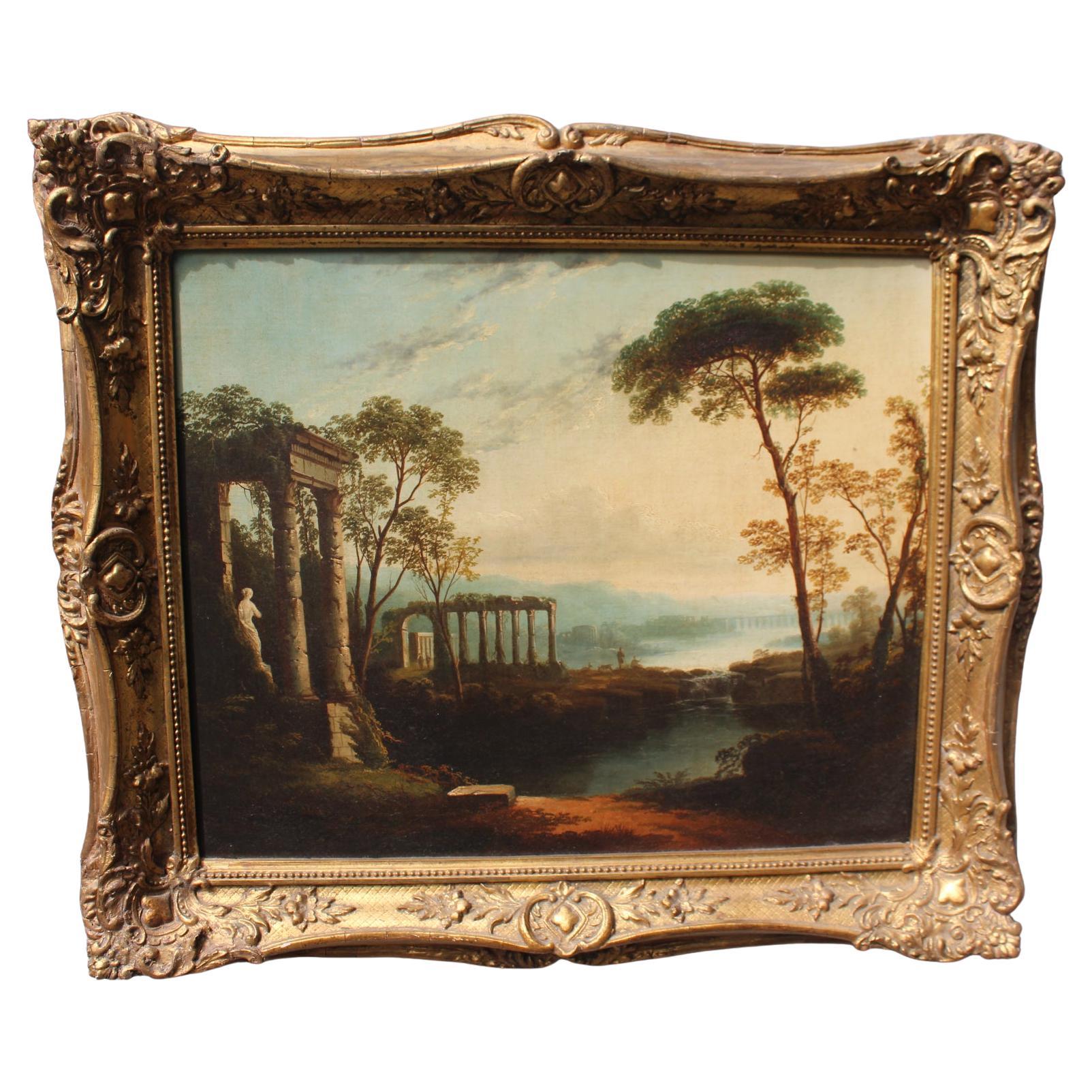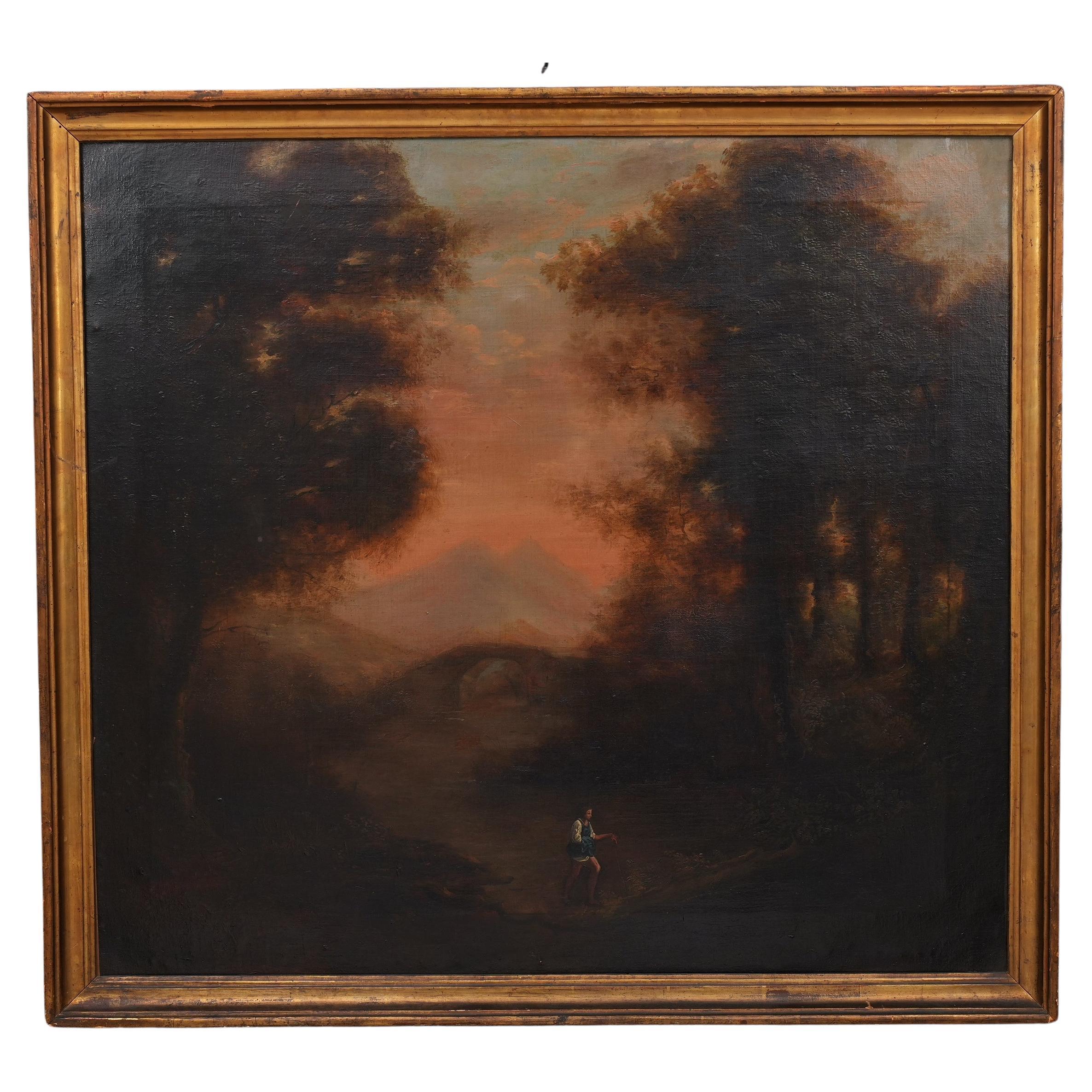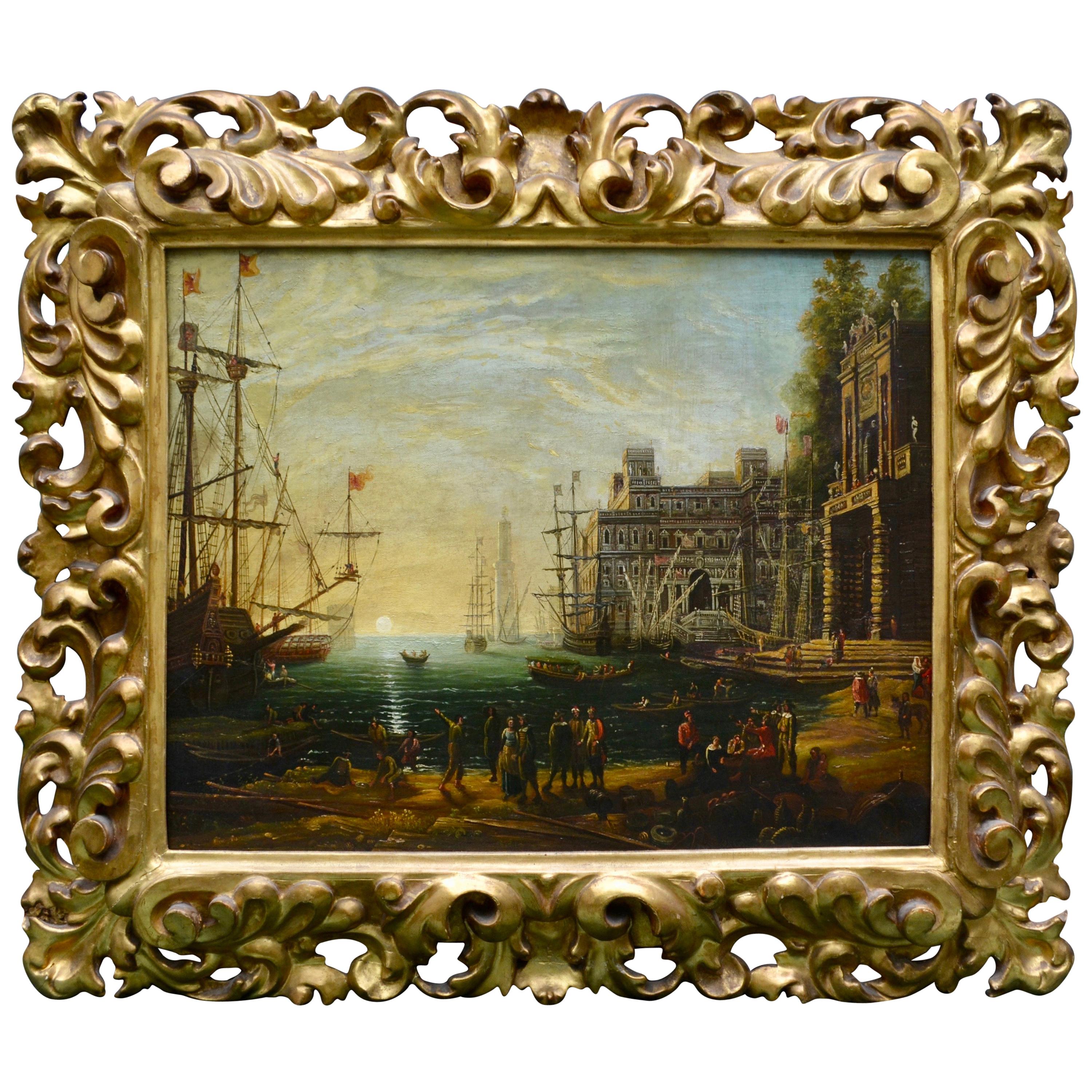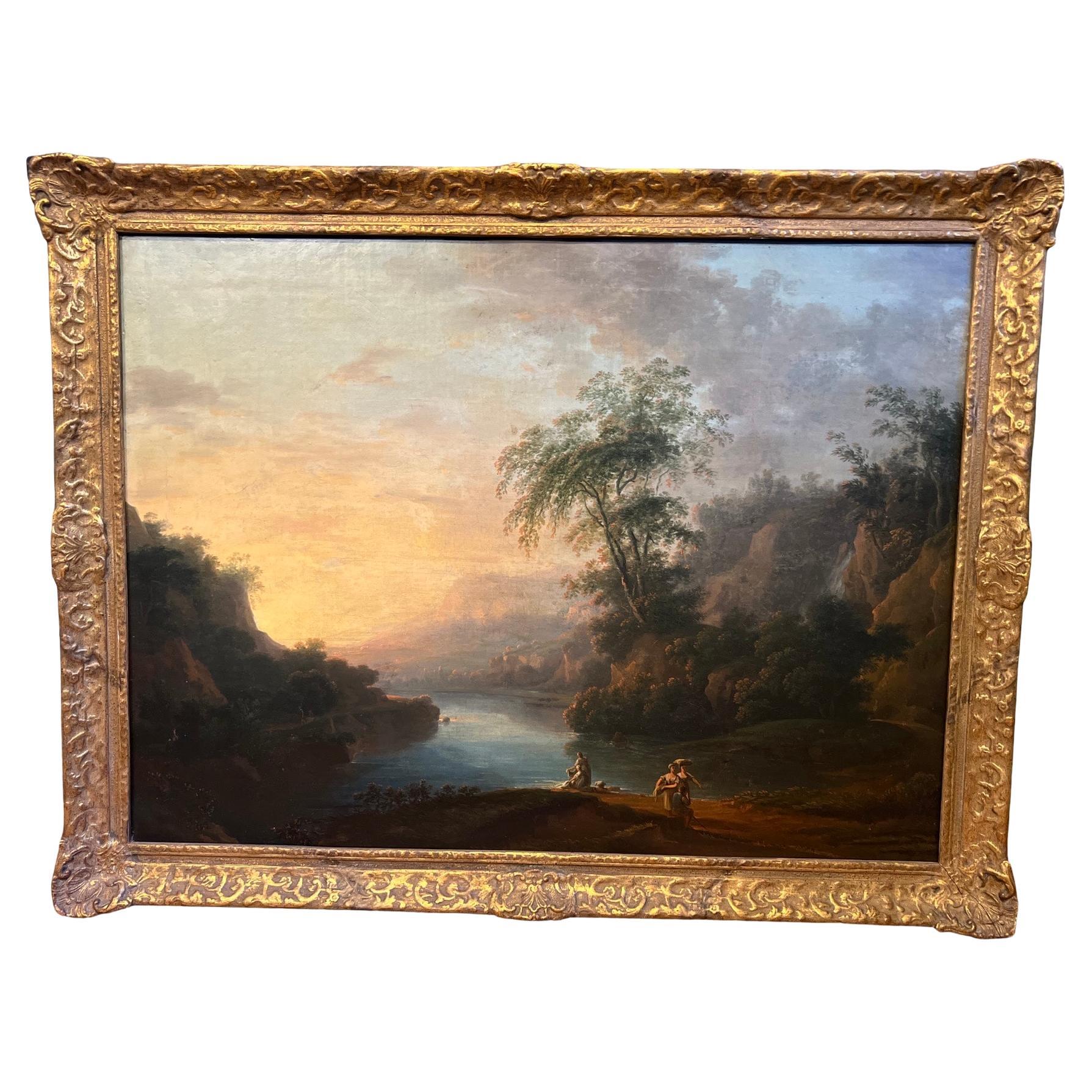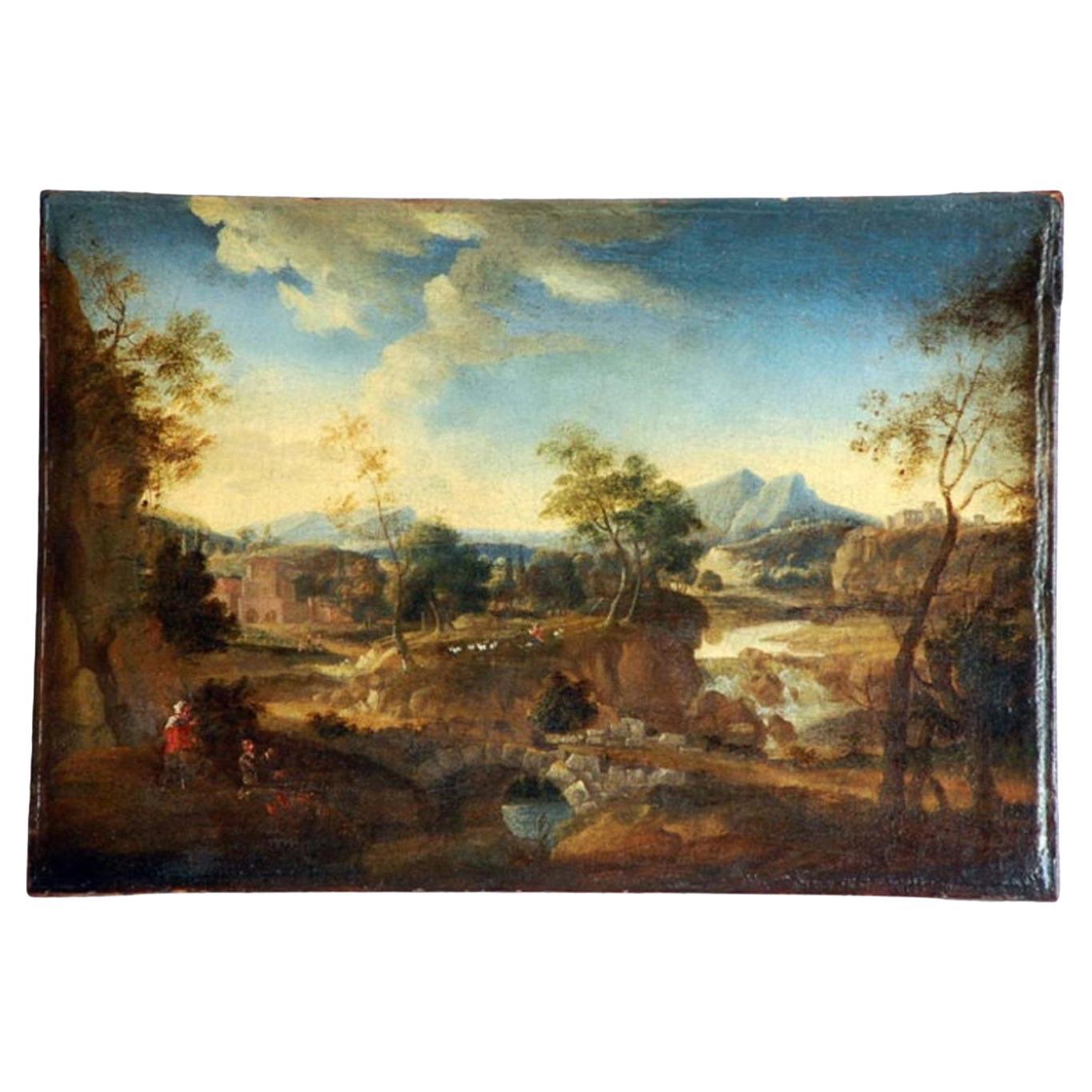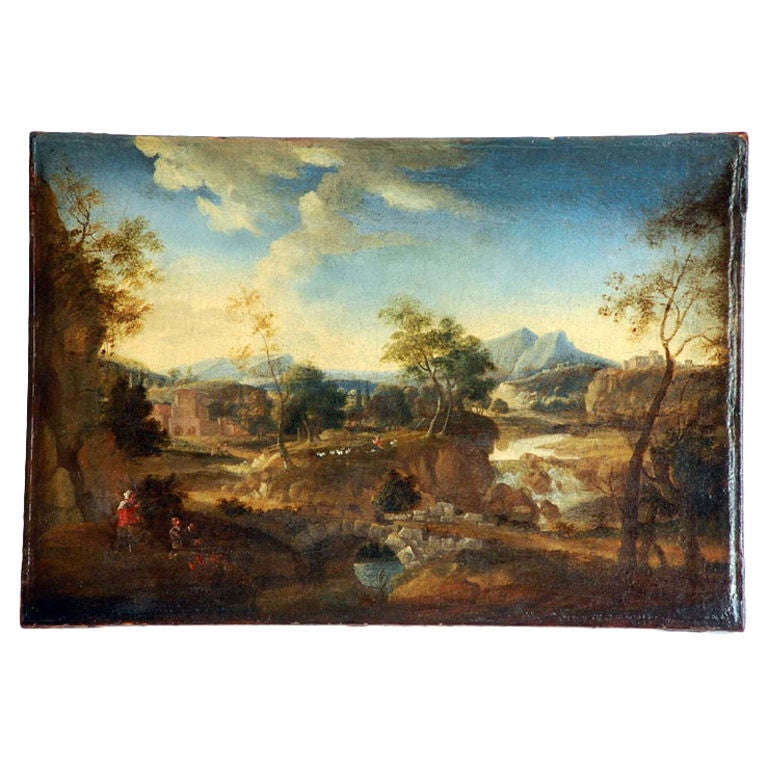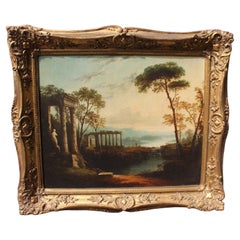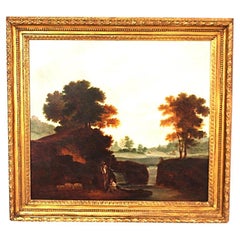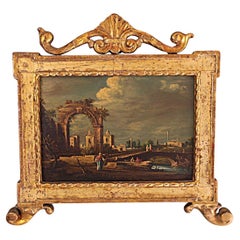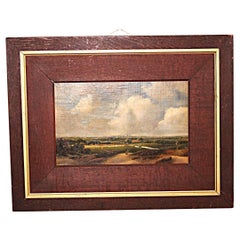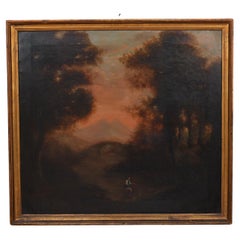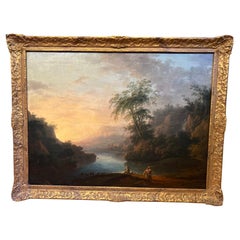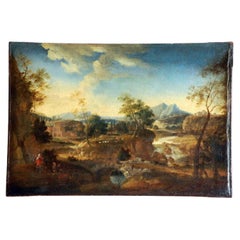Items Similar to Manner of Claude Lorrain Merchants on the banks of the river po
Want more images or videos?
Request additional images or videos from the seller
1 of 15
Manner of Claude Lorrain Merchants on the banks of the river po
$4,977.94
$6,222.4320% Off
£3,600
£4,50020% Off
€4,242.32
€5,302.9020% Off
CA$6,897.19
CA$8,621.4920% Off
A$7,489.01
A$9,361.2620% Off
CHF 3,965.98
CHF 4,957.4720% Off
MX$91,793.78
MX$114,742.2220% Off
NOK 49,080.53
NOK 61,350.6720% Off
SEK 46,378.50
SEK 57,973.1320% Off
DKK 31,662.96
DKK 39,578.7020% Off
About the Item
Italianate landscape, Manner of Claude Lorrain
Very good Quality oil on relined canvas in the Manner of Claude Lorrain, cargo ships on the banks of the river Po Italy.
📜 Provenance – Italianate Landscape after Claude Lorrain, England or Italy, circa late 18th–early 19th century
This finely executed oil on canvas is an accomplished historic copy after Claude Lorrain’s celebrated Italianate river landscapes, specifically related to his Landscape with Merchants (c. 1630s), held at the National Gallery of Art, Washington, D.C. The composition also bears a close resemblance to the 1769 engraving by Boydell and James Mason, after a painting once in the distinguished collection of Robert Trevor, 4th Baron Trevor, later 1st Viscount Hampden.
The scene features cargo ships along the tranquil banks of the River Po, enveloped in the soft, atmospheric light for which Claude Lorrain (1600–1682) is universally revered. Executed in the idiom of the Grand Tour period, the painting exemplifies the classical Arcadian themes sought by aristocratic collectors travelling through Italy in the 18th and early 19th centuries.
This work is a particularly elegant example of the period's taste for Claudean compositions, balancing architectural elements with expansive vistas and golden, diffused light. The canvas has been professionally relined and restored, housed in a contemporary frame that complements the work’s scale and palette. Minor craquelure and darkening to areas of the blue and green pigments remain consistent with age, enhancing its historic charm.
Ideal for integration into neoclassical, traditional, or transitional interiors, this work represents an opportunity to acquire a piece of decorative art with a strong visual lineage and academic relevance — a testament to Lorrain’s enduring influence across centuries of landscape painting.
Very similar to the Landscape with Merchants in the National Gallery of Art, Washington, D.C.
Our version could be after the engraving by Boydell and James Mason on 1st January 1769.
Interestingly, the source painting for the painting was once in the collection of Robert Trevor, 4th Baron Trevor (from 1764), and subsequently (from 1776) 1st Viscount Hampden.
18th-Century Italian Landscape in the Manner of Claude Lorrain
This exquisite 18th-century Italian Landscape in the manner of Claude Lorrain captures the essence of Italian Baroque landscape painting, showcasing the serene beauty and harmony of the classical countryside. Drawing inspiration from the Golden Age landscape painting, it reflects the elegance and detail characteristic of Claude Lorrain-style artwork, featuring sweeping vistas, balanced compositions, and an idealised landscape scene that exudes timeless charm.
A Classical Italian Countryside Painting
The painting masterfully depicts the tranquillity of a classical Italian countryside, combining light and shadow in art to create an immersive and atmospheric perspective. It resonates with the techniques of Baroque landscape art, emphasising harmony between natural elements and architectural features. This work is a fine example of old master-style painting, with its soft golden hues and delicate attention to detail, evoking the pastoral beauty of Italian Baroque landscapes.
Provenance and Condition
This antique landscape oil painting comes from a Sussex private collection and has been professionally cared for, ensuring its long-lasting appeal. It is a cleaned and restored painting, housed in a contemporary frame to enhance its presentation while preserving its original integrity. The painting measures 62 cm in height and 44 cm in width, making it a versatile piece for collectors and decorators alike.
A Decorative European Masterpiece
This collectable antique landscape painting is both a decorative centrepiece and an excellent investment in Baroque art. The combination of its antique painting with historical value and its refined aesthetic makes it a statement piece for art collectors. Whether admired for its fine art inspired by Claude Lorrain or its role as an elegant accent in a modern or traditional space, this painting embodies the enduring allure of classical European landscapes.
Timeless Countryside Charm
The serene beauty of this Italian pastoral scene offers a window into the idealised landscape scenes cherished by collectors and art enthusiasts. With its rich history and visual appeal, this decorative European masterpiece is a tribute to the timeless legacy of Claude Lorrain-style artwork and the artistic traditions of 18th-century Italy.
Claude was orphaned at a young age and was raised by his elder brother, who was a woodcarver. At the age of 13, he moved to Rome to work as an apprentice to the painter Agostino Tassi. In Rome, he became fascinated by the natural landscape and began painting landscapes himself.
Claude's paintings were highly influential in the development of landscape painting as a separate genre, and he became famous for his ability to capture the essence of nature in his works. His landscapes often featured idealised settings with a golden glow and soft, hazy light, giving them a dreamlike quality.
Claude was highly regarded during his lifetime and was patronised by many wealthy and influential individuals, including King Louis XIV of France. He spent most of his life in Rome but also travelled extensively throughout Italy and France. He was a member of the Academy of St. Luke in Rome and was highly respected by his fellow artists.
Claude's legacy as a painter has endured to this day, and he is considered one of the most important painters of the Baroque era. His influence can be seen in the works of many later artists, including J.M.W. Turner and John Constable.
Condition: Italianate landscape after Claude Lorrain
The canvas has been relined, re-stretched, cleaned, and restored and is housed in a contemporary frame. No major damage is visible to the naked eye. Some slight overpaint in the.
Slight craquelure to he sky and darkening to blues and greens
- Dimensions:Height: 24.41 in (62 cm)Width: 17.33 in (44 cm)Depth: 1.97 in (5 cm)
- Style:Baroque (In the Style Of)
- Materials and Techniques:
- Place of Origin:
- Period:
- Date of Manufacture:1760
- Condition:Refinished. Wear consistent with age and use. The painting has been cleaned, and the canvas relined. Some retouches to the sky.
- Seller Location:Seaford, GB
- Reference Number:1stDibs: LU10376244311062
About the Seller
New to 1stDibs
Joined in the past six months.
No Reviews Yet
Vetted Professional Seller
Every seller passes strict standards for authenticity and reliability
Established in 2021
1stDibs seller since 2025
Typical response time: 11 hours
- ShippingRetrieving quote...Shipping from: Seaford, United Kingdom
- Return Policy
Authenticity Guarantee
In the unlikely event there’s an issue with an item’s authenticity, contact us within 1 year for a full refund. DetailsMoney-Back Guarantee
If your item is not as described, is damaged in transit, or does not arrive, contact us within 7 days for a full refund. Details24-Hour Cancellation
You have a 24-hour grace period in which to reconsider your purchase, with no questions asked.Vetted Professional Sellers
Our world-class sellers must adhere to strict standards for service and quality, maintaining the integrity of our listings.Price-Match Guarantee
If you find that a seller listed the same item for a lower price elsewhere, we’ll match it.Trusted Global Delivery
Our best-in-class carrier network provides specialized shipping options worldwide, including custom delivery.More From This Seller
View AllManner of Claude Lorrain The Goat heard in Arcadian Landscape
By Claude Lorrain
Located in Seaford, GB
An Exquisite Italianate Arcadian Landscape Oil Painting
This late 18th-century Italianate classical landscape oil painting beautifull...
Category
Antique Late 18th Century European Baroque Paintings
Materials
Canvas, Paint
18th century of circle Richard Wilson pastoral Landscape
By Richard Wilson R.A.
Located in Seaford, GB
18th-Century Richard Wilson Landscape – A Masterpiece of British Old Master Art
This 18th-century Richard Wilson landscape, attributed to the circle of Thomas Jones, is a stunning pastoral landscape oil painting that embodies the charm of Georgian-era countryside artwork. As a fine example of British old master landscape art, this piece showcases the elegance and natural beauty of the English countryside, making it a perfect addition to any collection of antique rural landscape art.
A Romantic Countryside Painting with Timeless Appeal
The composition of this romantic countryside painting is thoughtfully balanced, featuring lush greenery, rolling hills, and a tranquil sky. The English countryside oil painting...
Category
Antique 18th Century English Georgian Paintings
Materials
Canvas
Antique Venetian capriccio oil painting
Located in Seaford, GB
Francesco Guardi Venice Oil Painting – Venetian Art in the Manner of Guardi
Exquisite 19th-Century Venetian Oil Painting
Experience the timeless elegance of Venetian art with this r...
Category
Early 20th Century Paintings
Materials
Pine, Paint
$1,714 Sale Price
20% Off
Dutch 19th century Landscape Painting
By Andreas Schelfhout
Located in Seaford, GB
This charming oil-on-paper painting captures a serene landscape near Haarlem, evocative of Andreas Schelfhout's masterful Dutch Romantic style. The work features a quintessentially D...
Category
Antique Late 19th Century Dutch Late Victorian Paintings
Materials
Paint, Paper
Early 19th century Capriccio Brazil School Painting
Located in Seaford, GB
Rare Early 19th century Capriccio view of Rio de Janeiro Painting
Probably painted circa 1810 by one of Jean-Baptiste Debret, Italian Students.
Painted on Sailcloth.
Historical Context of Early 19th Century Portuguese Colonial Brazil
1.1 Transition from Colony to Empire
During the early 19th century, Brazil underwent a seismic shift in its political status. Originally a colony under the Portuguese Empire, the arrival of the Portuguese Royal Court in Rio de Janeiro in 1808 rapidly elevated the city’s cultural and political importance. By 1815, Brazil was declared a kingdom united with Portugal, setting the stage for the emergence of the Empire of Brazil in 1822. This period of transformation—often termed the transitional period from colony to empire—fueled a wave of artistic production in cities like Rio de Janeiro.
1.2 European Artistic Influence in Brazil
With the French Artistic Mission in Rio (initiated in 1816) and the presence of various Portuguese and European artists, Brazilian art of the early 1800s began to reflect diverse influences, from neoclassical painting to the early rumblings of romanticism. Painters such as Jean-Baptiste Debret, and Nicolas-Antoine Taunay, and local luminaries like Manuel de Araújo Porto-Alegre contributed to the fine arts tradition in Brazil. Their works featured scenes of local life, portraits of Brazilian society, and imaginative vistas—sometimes referred to as “capriccios,” in which real elements were combined with artistic liberties to create an idealized panorama.
1.3 Rio de Janeiro as Cultural and Political Hub
Rio de Janeiro, often called the Imperial capital after Brazil’s independence, was home to foundational institutions like the Imperial Academy of Fine Arts (Academia Imperial de Belas Artes). Later evolving into the Escola de Belas Artes (School of Fine Arts in Rio), these academies nurtured the talents of emerging painters, who found patronage under the Royal Court and, subsequently, the Imperial Court. The city’s significance was further enhanced by the construction of significant buildings, the modernization of infrastructure, and the mingling of European courtly customs with the traditions of local inhabitants.
. Description of the Octagonal Oil on Canvas: A Capriccio View of Rio de Janeiro
2.1 Composition and Layout
The most striking characteristic of this 19th-century Brazilian art piece is its octagonal shape, a relatively unusual format that draws the viewer’s gaze toward its centre. The composition showcases Rio de Janeiro’s shoreline in the early 1800s, brimming with merchant ships and smaller boats anchored near the shore. On the sand, there is a bustling crowd of local people—men and women carrying food and goods on their heads, loading and unloading boats, and engaging in everyday commerce. The backdrop of soaring mountains suggests Rio’s iconic topography, embodying the landscape that famously defines the city.
2.2 Architectural and Religious Landmarks
On the left side, one can discern the silhouette of a church believed to be Santa Lucia, a significant religious structure in the heart of early 19th-century Rio. This element provides viewers with a tangible reference point, linking the scene to an actual location. However, because this painting is labelled as a “capriccio,” the artist might have taken creative liberties by rearranging or amplifying certain features of the city. The melding of real and idealized elements is characteristic of these imaginative vistas.
2.3 Evoking Daily Life in Colonial Rio
One of the painting’s greatest appeals lies in its portrayal of daily life during the colonial era. Men and women from various backgrounds populate the scene. Some appear to be carrying goods on their heads, a common practice in Brazil that has persisted through different centuries. Others appear to be haggling or trading near small vessels, revealing the commercial pulse of an active port city. This focus on local people, combined with the grandeur of merchant ships, captures the tension and synergy between the every day and the extraordinary—a hallmark of Brazilian colonial painting that balances the grand narratives of empire with the rhythms of ordinary life.
2.4 An Amalgamation of Neoclassical and Romantic Influences
Although academic art in early 19th century Brazil was highly influenced by neoclassicism, the onset of romanticism can be spotted in the emotional portrayal of the sky, the lively palette, and the dramatic emphasis on nature’s beauty (the mountains, in particular). This duality reflects the fine arts tradition in Brazil during the transitional phase when artists were embracing multiple styles. As part of the School of Rio or the Rio de Janeiro school, painters often integrated academic techniques learned from European masters with emerging local subjects and influences.
3. Institutions and Artistic Movements
3.1 Imperial Academy of Fine Arts
Originally known as the Royal School of Sciences, Arts, and Crafts, the Imperial Academy of Fine Arts in Rio de Janeiro was instrumental in shaping 19th-century Brazilian art. Influential artists and teachers from Portugal, France, and other European nations congregated at the Academy, imparting their expertise to native students. As the monarchy consolidated power, the Academy enjoyed royal patronage, leading to the creation of Imperial Academy-style works that combined European academic rigour with Brazilian-themed subject matter.
3.2 Impact of the French Artistic Mission
The French Artistic Mission, which arrived in 1816, played a pivotal role in introducing advanced European artistic techniques, thereby elevating the overall quality of painting in Brazil. Artists like Jean-Baptiste Debret not only documented Brazilian society but also spearheaded the development of a local visual identity that aligned with both academicism and the national context of a blossoming empire. Debret, alongside others such as Nicolas-Antoine Taunay, mentored Brazilian artists, sowing the seeds of what would become the Brazilian academic art movement.
3.3 Religious, Historical, and Landscape Paintings
In addition to everyday scenes and historical compositions, religious iconography remained crucial throughout Portuguese colonial and imperial Brazil. Churches were omnipresent in cityscapes like Rio de Janeiro. Many colonial-era Brazilian portraits...
Category
Antique Early 19th Century Brazilian Spanish Colonial Paintings
Materials
Canvas
$2,986 Sale Price
20% Off
Early 19th century horse painting
By Dean Wolstenholme
Located in Seaford, GB
A Timeless Depiction of the English Fox Hunt
The early 19th-century fox hunting scene, attributed to Dean Wolstenholme Elder, is a stunning representation of the aristocratic traditi...
Category
Antique 1810s English Regency Paintings
Materials
Canvas
You May Also Like
17th Century Oil Painting School of Claude Lorrain
By (after) Claude Lorrain (Claude Gellée)
Located in 263-0031, JP
A copy of the 1636 painting “River Ford” by the French proto-plein-air painter Claude Lorrain (1600-1682). This suivier, or follower, has faithfully reproduced the original but revis...
Category
Antique 17th Century European Paintings
Materials
Canvas
18th Century Copy of "Port Scene with the Villa Medici" after Claude Lorrain
By Claude Lorrain
Located in Vancouver, British Columbia
A late 18th century copy of a painting by Claude Lorrain titled, "Port scene with the Villa Medici" the original painted in 1637 and now hanging in the Uffizi Gallery in Florence. Th...
Category
Antique Late 18th Century Italian Baroque Paintings
Materials
Canvas
18th Century, Old Master European Landscape Painting Italian School
Located in Atlanta, GA
Italian School, 18th century.
A masterful example of 18th-century Italian School artistry, this Old Master landscape painting captures the sublime beauty of an idealized European co...
Category
Antique 18th Century Italian Baroque Paintings
Materials
Canvas, Giltwood, Paint
$6,000 Sale Price
20% Off
Early 17th Century French Landscape Painting
Located in Los Angeles, CA
Early 17th century French landscape painting. Unframed.
Category
Antique Early 17th Century French Louis XIV Paintings
Materials
Canvas, Paint
Early 17th Century French Landscape Painting
Located in Los Angeles, CA
Early 17th century French landscape painting. Unframed.
Category
Antique Early 17th Century French Louis XIV Paintings
Materials
Canvas, Paint
Jan Frans van Bloemen called Orizzonte (Antwerp 1662-Rome 1749), Roman Landscape
Located in CH
Jan Frans van Bloemen called Orizzonte (Antwerp 1662-Rome 1749).
A Late 17th early 18th century Italian landscape with figures of the Roman Campagna.
...
Category
Antique Late 17th Century Dutch Baroque Paintings
Materials
Canvas
More Ways To Browse
Altar Set
Antique Desk Types
Antique Grenade
Antique Metal Containers
Antique Pewter Dish
Antique Portuguese Chest Of Drawers
Antique Stepping Stones
Apothecary Chests And Drawers
Argento 800
Arne Wahl Iversen For Vinde Mobelfabrik
Art Deco Counter
Art Nouveau Sterling Silver Photo Frame
Bank Table
Bird In The Hand Compact
Black Chinese Chests
Block Front Chest
Blue Bohemian Crystal
Blue Chinese Cloisonne
